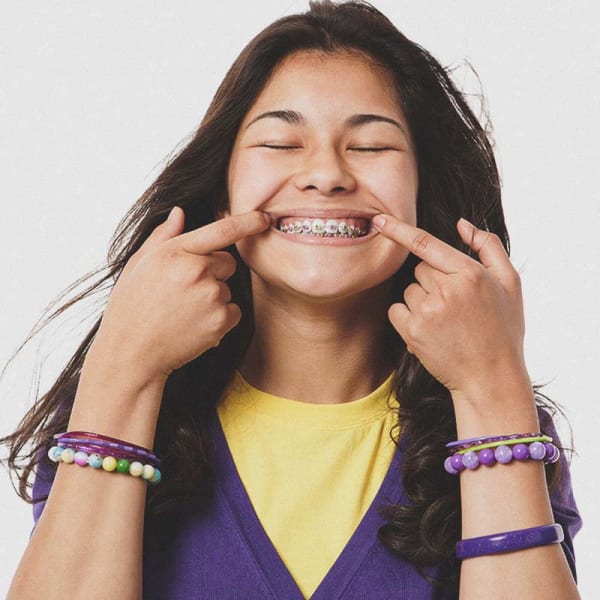Life With Braces
Live Your Best Life with Braces
Braces might sound a bit scary, but we promise that living with braces is much easier than you think. Just a few small tweaks to your normal routine and you’re on your way to a healthier, confident smile.
Topics on This Page:

Brushing and Flossing with Braces
It’s important to keep good oral hygiene while wearing braces to prevent stains, gum disease and tooth decay. When the braces come off, you want your teeth and smile to shine! Also, good hygiene will keep your braces in top condition, making sure they function at their best.
In addition to frequent brushing and flossing, Dr. Reichard recommends rinsing with a cavity-fighting mouthwash and keeping regular checkups with your family dentist.
Brushing with Braces
Patients with braces should brush their teeth each morning, each evening and after every meal. If you dine away from home, keep a small travel kit with a toothbrush, toothpaste, floss and floss threader with you; if you’re in a pinch, generously rinse your mouth with water and brush/floss when you return home.
Use a soft-bristled toothbrush and a pea-sized amount of fluoride toothpaste, brushing in small circular motions for at least two minutes. Be sure to brush the front, back and top of each tooth, in addition to your gum line. Angle your toothbrush to reach between the brackets and wires.
The brackets can wear down your toothbrush faster than normal, so be prepared to replace your toothbrush when it starts looking frayed or worn.

Flossing with Braces
Your teeth and braces should be flossed at least once a day, and preferably after each meal, to remove food and plaque that your toothbrush missed. Flossing with braces entails two specific pieces of equipment – waxed dental floss and a floss threader.
Dental floss comes in waxed and unwaxed versions. Patients with braces should use the waxed version, in which a thin layer of wax has been applied to the floss to prevent shredding and promote easier gliding.
A floss threader looks like a small lasso or threading needle. It has a small, thin handle on one end and a loop on the other end.
Simply cut a piece of waxed floss about 18″ long. Pull about 4-5″ of the floss through the threader’s loop. Then, pass the threader under the wire on each tooth and in between every tooth. Be sure to slide the floss up and down each side of the tooth all the way to your gum line.
Eating with Braces
Cut foods into small pieces, especially items you would typically use your front teeth to bite at like corn on the cob, apples and carrots. Use your back teeth for chewing.
If your teeth are feeling a bit sensitive, stick to soft foods like yogurt, cooked and mashed soft vegetables or soup. You can also sooth discomfort with cold items like smoothies or ice water…just don’t chew on the ice!
Avoid the following foods that can damage your braces:
- Sticky foods like gum, caramels, taffy, licorice, fruit chews and gummy candy
- Chewy foods like pizza crust and bagels
- Hard foods like nuts, ice, hard candies and crusty bread
- Crunchy foods like popcorn, corn chips/tortilla chips, hard taco shells and raw apples and carrots
While not food, you should also avoid chewing on fingernails, pencils, pens, etc. Enjoy sugary sweets and drinks in moderation and be sure to brush and floss afterward.
Tips to Make Your Mouth More Comfortable
While braces will feel different and weird at first, we think you’ll be surprised at how quickly you adjust to them. In fact, you might even forget you’re wearing them!
Create an on-the-go kit! Here are our suggestions for some portable care items for braces:
- Dental wax
- Travel-size, compact or foldable toothbrush
- Travel-size toothpaste
- Waxed dental floss and floss threader
- Travel-size container of pain reliever
- Travel-size bottle of mouth rinse
- Compact mirror
You may feel general soreness or have sensitive teeth for a few days after your braces are put on or after an adjustment. Take your preferred over-the-counter pain reliever as directed and needed. You can also try applying a wrapped ice pack to your cheek for external relief. Or, enjoy a cold treat like a smoothie. Stick to soft foods like scrambled eggs, applesauce, cottage cheese, gelatin, pudding or yogurt.
Your lips, tongue and cheeks may become irritated as you adjust to your braces. It may take 1-2 weeks for these soft tissues to toughen and acclimate to their new environment. Swish a salt water solution (1 teaspoon of salt dissolved into 6-8 oz of warm water) and spit out. Then, cover any wire or brackets causing the irritation with the dental wax we supply.
This is a normal and expected part of orthodontic treatment. In order to move, teeth must loosen first. After treatment is complete, the teeth will firm up in their new, corrected positions. If one or more teeth feel loose, leave it/them alone as much as possible. It can be second-nature to unconsciously manipulate weird-feeling things in our mouth with our tongue or even with our fingers, so try to be mindful about not doing so.
It’s important to let Dr. Reichard know if you participate in any sort of contact or impact sport, whether it’s organized or just casual. You will need to wear a protective mouthguard in those instances.

Emergency Care for Braces
Orthodontic accidents do happen from time to time. We call them emergencies because they need our review and input to resolve, but they are not life-or-death situations. You can usually manage the emergency at home with some simple self-care until we can connect with you.